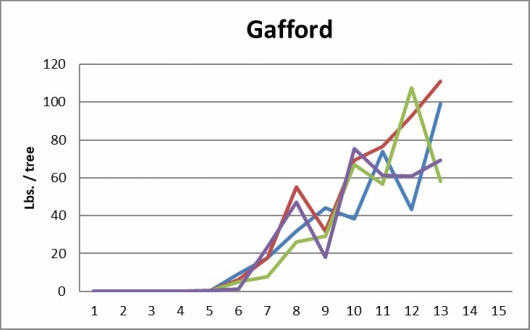Gafford
Table 1. Yield and quality of ‘Gafford’ over 13 years.
| Cultivar | Avg. Yield (yrs 1-15) | #Nuts/lb. | %Kernal | Cluster Size | 50% shuck split | ||
| lbs./tree/year | |||||||
| Gafford | 30 | 50 | 50% | 2.6 | Oct. 11 | ||
| Desirable | 21 | 44 | 49% | 2.5 | Oct. 11 | ||
Fig. 1. Individual tree yield of ‘Gafford’ over 13 years (2005-2017). Each line indicates the yield of a separate tree.

Table 2. Average pest resistance of test cultivars in a sprayed orchard 2005-2017.
| Cultivar | Leaf ScabZ | Nut ScabY | Nut ScabX | Black Aphid DamageW |
| Avg. | Avg. | Worst | Avg. | |
| Gafford | 1.0 | 1.0 | 1.0 | 1.0 |
| Desirable | 2.8 | 3.5 | 4.7 | 1.5 |
- z1 = no scab lesions, 2 = a few isolated lesions with restricted growth, 3 = multiple lesions with expanding growth, 4 = stem scab lesions or defoliation.
- y1 = no scab lesions, 2 = a few lesions with restricted growth, 3 = multiple lesions, 0% to 10% coverage, 4 = 11% to 50% coverage, 5 = 51% to 100% coverage or nut drop. Average damage seen on nuts over the tree.
- x1 = no scab lesions, 2 = a few lesions with restricted growth, 3 = multiple lesions, 0% to 10% coverage, 4 = 11% to 50% coverage, 5 = 51% to 100% coverage or nut drop. Maximum damage seen on any nut.
- w1 = no damage, 2 = light chlorotic spotting, 0% to 25% leaves affected, 3 = moderate chlorotic spotting, 26% to 75% chlorotic spotting, 4 = heavy chlorotic spotting, 76% to 100% leaves affected.
History
An Alabama seedling selected By Dr. Bill Goff for its excellent pest resistance.
Comments
Yields of ‘Gafford’ have been good (Table 1), and we are continuing to test this cultivar. Yields have been improving and alternation has not be bad (Fig. 1). Tests in Alabama indicate that crop thinning may eventually be needed, but we have not reached that point yet in our testing.
Quality of the Gafford nut is only mediocre. Our nuts averaged 50 nuts / lb. and 50% kernel. Color of the kernel was average to dark, and kernel spotting and fuzz were common (see picture below), and we often chipped our ‘Gafford’ kernels during shelling. Harvest date is late, similar to ‘Sumner’.
We have not seen ‘Gafford’ have any scab in our sprayed trials, and most reports show ‘Gafford’ having excellent scab resistance. We also saw little aphid damage in our trials. However, we did seem to see more mite damage in ‘Gafford’ than some other cultivars, so growers should monitor this pest in late summer.
'Gafford' is a late shedding type I cultivar, and looks similar to ‘Cape Fear’ in its pollen shed times. ‘Gafford’ would be pollinated by ‘Cherryle’, ‘Excel’, ‘Giftpack’, Headquarters’, ‘Kiowa’, ‘Lakota’, ‘McMillan’, ‘Lakota’, ‘Sumner’, and ‘Zinner’. ‘Gafford’ should also serve a late season pollinizer for most of these as well.
This tree was selected for low-input plantings and will likely only be useful to growers who need excellent pest resistance. To me, its main competitor is 'McMillan'. We have tested both, and at this point, I prefer 'McMillan' to 'Gafford'. While 'Gafford' is slightly bigger than 'McMillan' (50 vs. 52 nuts/lb), and shows less alternation, 'McMillan is earlier than 'Gafford' and had less kernel spotting and fuzzing. However, Dr. Goff rates scab resistance in 'Gafford' as superior to 'McMillan', as 'McMillan' scabs in his tests similar to 'Sumner'. Also of note is that ‘Gafford’ is one of the few cultivars with type I pollination and high levels of scab resistance. ‘Gafford’ is relatively rare in Georgia and you will need to call around in order to find trees of this cultivar. It is more common in Alabama.
More information is available on 'Gafford' from the Alabama Pecan Growers website.




